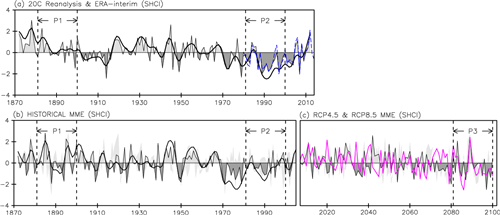The Siberian high under global warming in CMIP5 models
Date:2015-04-07
TheSiberian high (SH)experienced a decline from the 1970s to 1990s and a recovery in recent years. The evolution of the SH underglobal warmingis unclear. In this study, 41 Coupled Model Intercomparison Project Phase 5 (CMIP5) climate models are evaluated in terms of their ability to simulate the temporal evolution of the SH in the 19th and 20th centuries and the spatial pattern of the SH during 1981–2005. The results show that 12 models can capture the temporal evolution of the SH center intensity (SHCI) for 1872–2005. The linear correlation coefficient between the SHCI from the Twentieth Century Reanalysis and the simulated SHCI from the multi-model ensemble (MME) of the 12 models is 0.3 on annual and inter-annual scales (above the 99% confidence level). On decadal and multi-decadal time scales, the MME also captures the pronounced reduction (between1981–2000 and 1881–1900 period) and the recovery (during 1991–2005) of the SH intensity. Finally, the future evolution of the SH is investigated using the MME of the 12 models under the +4.5 and +8.5 W m?2 Representative Concentration Pathway (RCP) scenarios (RCP4.5 and RCP8.5).It is shown that the SHCI, similar to the SHCI in the 20th century, has no significant long-term trend in the21stcentury under global warming (RCP8.5 scenario). At the end of 21st century (2081–2100), the SH shows stronger interannual variability than the SH at the end of 20th century (1981–2000). The increased interannual variability likely favors the increased interannual variability in winter air temperature over midlatitudeEurasia at the end of 21st century.

Normalized and 9-yr running mean of winter SHCI derived from (a) 20C Reanalysis for 1872–2012(black solid line)/ERA-Interim for 1980–2014 (blue dashed line) and (b) historical simulations for 1872–2005. (c) Normalized winter SHCI derived from RCP4.5 (blacksolid line) and RCP8.5 (pink solid line) scenario simulations for 2007–2100. In (b, c), shading indicates the inter-model standard deviation
Citation: Li, F., and Y.-Q. Gao, 2015: The Siberian high under global warming in CMIP5 models, Atmos. Oceanic Sci. Lett., 8, doi:10.3878/AOSL20140101.
Link: http://159.226.119.58/aosl/EN/abstract/abstract551.shtml
